John Steven Lasher's Kinopanorama |
This article first appeared in |
|
Written by: John Steven Lasher |
Issue 38 - April 1995 |
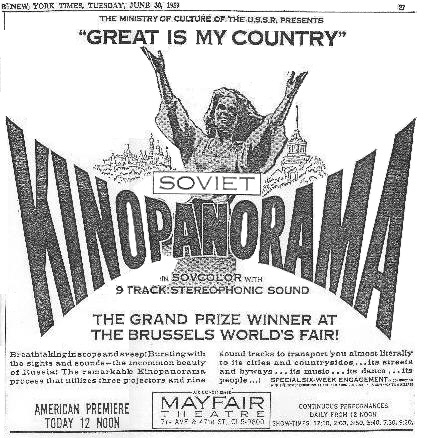 The
original Russian Kinopanorama logo in New York Times The
original Russian Kinopanorama logo in New York TimesJune 1993. The Pictureville Cinema in Bradford, England - the only public theatre anywhere where all the original 3-strip films can be exhibited in their original format - is launched to critical acclaim. "This is Cinerama", which hasn't been seen for over twenty years, receives a tremendous reception. To honour this historic event Sydney film producer John Steven Lasher brought the historic Kinopanorama camera out of retirement to shoot the first new 3-strip film in over thirty years. John Steven Lasher developed the idea for a short promotional travel-related film about Australia, New South Wales and Sydney, host city of the 2000 Olympics, which would be shot in the three-strip Cinerama process, and offered the film to Pictureville on an exclusive basis. Although an original 3-strip Cinerama camera was being restored by two former Cinerama staff in California, USA, Mr Lasher was unable to secure its hire. He considered the rival Cinemiracle process, but was informed that only months earlier the sole remaining Cinemiracle cameras had been disassembled and reconverted for 35mm special effects use. The only other 3-strip process to his knowledge was Kinopanorama, the Soviet version of Cinerama, about which the West knew practically nothing. Was it possible that any of the Russian cameras existed; if so, could they be located, restored and purchased? |
More
in 70mm reading: |
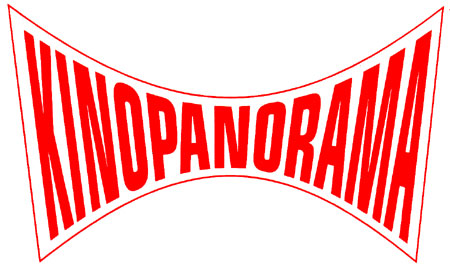 Fifth
Continent's Kinopanorama logo which looks like a total rip-off of the
original Soviet Kinopanorama logo above. Fifth
Continent's Kinopanorama logo which looks like a total rip-off of the
original Soviet Kinopanorama logo above.For Mr Lasher, who with the assistance of Yuri Sokol, former Soviet filmmaker, now resident in Australia, the answer after many months was a resounding yes! A Kinopanorama camera, complete with two sets of lenses, camera magazines, DC and sync motors, and tripod, was located and restored under the supervision of Sergei Rozhkov, the Russian scientist who in 1991 was awarded an Oscar by the Academy of Motion Picture Arts and Sciences for his role in the development of advanced 3-D films in Russia. After successfully passing its initial tests in Russia, the camera, together with its restorers, was flown to Sydney. Cinema history was recreated on Tuesday night, September 27, 1993 in Sydney, Australia. Shortly after dark John Mitchell, who owns one of only three extant Cinerama 3-strip theatres in the world, projected "rushes" of the first new footage shot in any 3-strip panoramic motion picture process in some 30 years! |
|
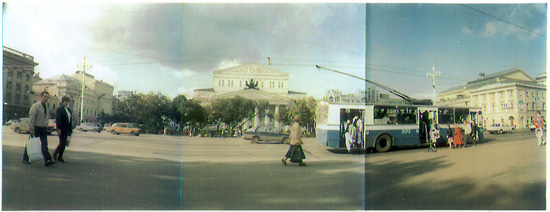 3-strip
Kinopanorama composite. Reproduced by permission. Fifth Continent. 3-strip
Kinopanorama composite. Reproduced by permission. Fifth Continent.
There were no fanfares (in fact, no music was heard), no press, no speeches, and no TV cameras (though the footage projected on screen was captured on video). There was, however, the unique experience of seeing this unique footage shot with the painstakingly restored Kinopanorama camera, purchased by Fifth Continent Movie Classics. If the Sovcolor film stock was a bit muted on account of Moscow's overcast weather, the matters at hand were more than compensated for by the flawless performance of the camera, which not only captured the scenes of various Moscow landmarks in sharp focus, but also exhibited rock-steady synchronization between the 3 panels. On November 2, following the arrival of the Kinopanorama camera and crew from Moscow, several minutes of additional test footage shot around Moscow was viewed by the production crew. Again, the camera performed brilliantly. It was now time to film in various locations around Sydney over the next several days. |
|
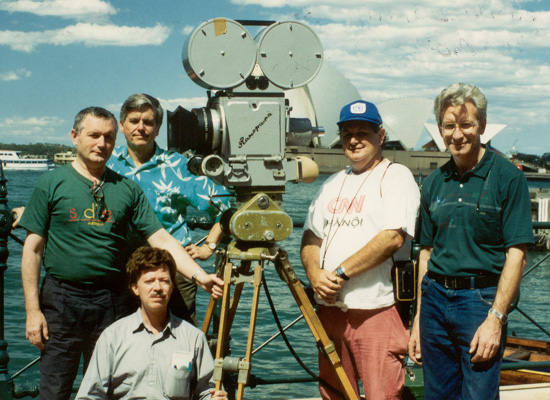 Kinopanorama
crew
in Sydney including. Director of Photography John R. McLean, Producer John
Steven Lasher, and Technical liaisons Sergey Rozhkov, Igor
Shevtsov and John Mitchell (in a blue shirt). Producer John
Steven Lasher at the bottom. Copyright Kinopanorama Music & Vision. Kinopanorama
crew
in Sydney including. Director of Photography John R. McLean, Producer John
Steven Lasher, and Technical liaisons Sergey Rozhkov, Igor
Shevtsov and John Mitchell (in a blue shirt). Producer John
Steven Lasher at the bottom. Copyright Kinopanorama Music & Vision.Day one of the filming on Wednesday, November 3, 1993 took place at the ANA Sydney Hotel, where the camera and crew were lodged for the week. From the roof above the fortieth floor Director of Photography John R. McLean, Producer John Steven Lasher, and Technical liaisons Sergey Rozhkov, Igor Shevtsov and John Mitchell hoisted the camera on a heavy-duty German tripod (c. 1940), connected the two 12-volt batteries to the camera's DC motor, turned the voltage regulator on, and -- voila -- 146 degree panoramic views of Sydney Harbour, the "Coathanger", Sydney Opera House and everything else the magnificent camera could capture from such a lofty vantage point. |
|
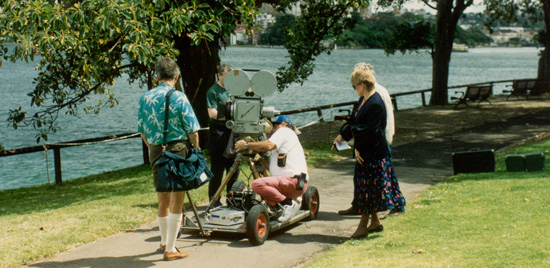 Kinopanorama
camera in Sydney harbour. Reproduced by
permission from Fifth Continent Kinopanorama
camera in Sydney harbour. Reproduced by
permission from Fifth ContinentFilming on Thursday, November 4, included the Royal Botanic Gardens Sydney (Mrs Macquaries's Chair, Farm Cove, Vista Pavilion, Twin Ponds and Queen Elizabeth II Gate), Sydney Opera House and Campbell's Cove, where the arrival of H.M.A.V. Bounty was captured. Friday morning shots covered a ride across the Sydney Harbor Bridge, thence back to Campbell's Cove for a 1300 hours departure aboard H.M.A.V. Bounty (the full size replica built for the 1984 film "Bounty" starring Mel Gibson and Anthony Hopkins) courtesy of captain John Sorensen and Bounty Cruises. This popular Sydney Harbor Cruise provided the film crew with the perfect opportunity to shoot the kind of panoramic footage for which the Kinopanorama camera is famous. With the November weather at its most cooperative the crew decided to shoot extra footage on Saturday, November 6, at the North Head Scenic area from the Fairfax Lookout. This location offers one of the finest vistas available, offering spectacular views of North and Middle Harbours, South and Middle heads, the skylines of Sydney, North Sydney, Manly and Chatswood. The day's shoot ended at Bilgola Head, where more seascapes were captured in vivid detail. With several metres of film remaining the production crew decided to "get into the picture": John R. McLean framed the scene, someone yelled "action", and with the Kinopanorama camera at speed, the crew offered a salute to the three-eyed wonder. |
|
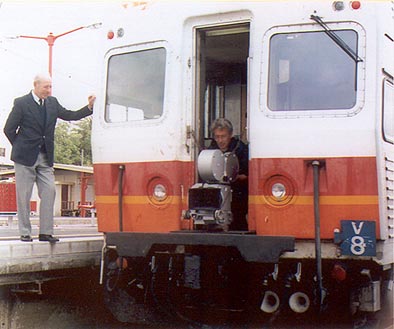 Kinopanorama
camera on a Sydney train. Reproduced by
permission from Fifth Continent Kinopanorama
camera on a Sydney train. Reproduced by
permission from Fifth ContinentOn Monday, November 8, camera and crew boarded the 0847 train from Central to Wyong as guests of CityRail management. This ride offers some of the most exciting footage to date. The Kinopanorama camera was mounted on the floor of the front carriage, positioned only meters above the rail, where footage of the journey would be shot while the train was operating at high speed. Footage between Wyong and Sydney included the scenic Hawkesbury south of Woy Woy, a high-speed race across the Railway Bridge at Brooklyn, and, between Hornsby and Strathfield, caught the engine driver's "point of view" as the train overtook and crossed other trains on one of the busiest sections on the CityRail network. Of course, this is but the shape of things to come. The Sovcolor film stock, which was processed and printed in Moscow under the supervision of Sergey Rozhkov, arrived back in Sydney on May 16, 1994. The "work-print" has been evaluated, and the best scenes will be edited into a rough-cut for initial post-production work, which will include added narration, John Charles' score and sound-effects on a digitally mastered seven-track stereo surround. "H.M.A.V. Bounty" was shot in Sovcolor (print by Eastman Kodak) by John R Mclean and Yuri Sokol, John Charles, best known in Australia for his music from "The Quiet Earth", has composed an original score which compliments the visuals. John Mitchell, who owns one of three extant three-strip projection facilities in the world, is the technical consultant. John Steven Lasher, producer & director, has final script development through funding from the corporate sector, whose sponsorship includes "contras" for those goods and services featured in the film. |
|
| . | |
|
Go:
back
- top
-
back issues Updated 21-01-24 |
